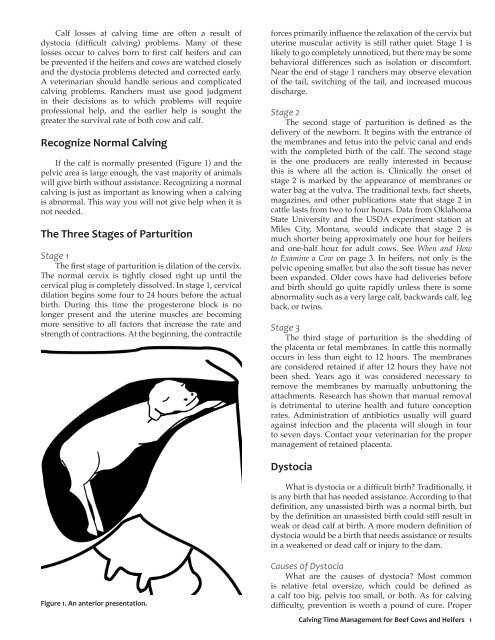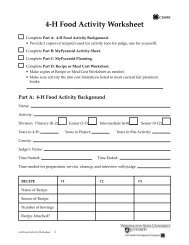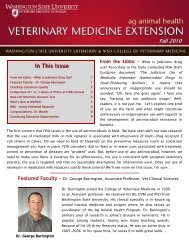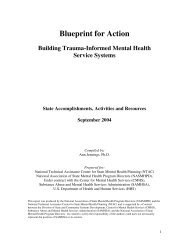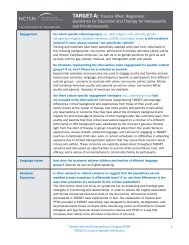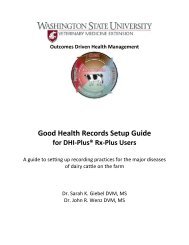Calving Time Management for Beef Cows and ... - OSU Fact Sheets
Calving Time Management for Beef Cows and ... - OSU Fact Sheets
Calving Time Management for Beef Cows and ... - OSU Fact Sheets
- No tags were found...
Create successful ePaper yourself
Turn your PDF publications into a flip-book with our unique Google optimized e-Paper software.
Calf losses at calving time are often a result ofdystocia (difficult calving) problems. Many of theselosses occur to calves born to first calf heifers <strong>and</strong> canbe prevented if the heifers <strong>and</strong> cows are watched closely<strong>and</strong> the dystocia problems detected <strong>and</strong> corrected early.A veterinarian should h<strong>and</strong>le serious <strong>and</strong> complicatedcalving problems. Ranchers must use good judgmentin their decisions as to which problems will requireprofessional help, <strong>and</strong> the earlier help is sought thegreater the survival rate of both cow <strong>and</strong> calf.Recognize Normal <strong>Calving</strong>If the calf is normally presented (Figure 1) <strong>and</strong> thepelvic area is large enough, the vast majority of animalswill give birth without assistance. Recognizing a normalcalving is just as important as knowing when a calvingis abnormal. This way you will not give help when it isnot needed.The Three Stages of ParturitionStage 1The first stage of parturition is dilation of the cervix.The normal cervix is tightly closed right up until thecervical plug is completely dissolved. In stage 1, cervicaldilation begins some four to 24 hours be<strong>for</strong>e the actualbirth. During this time the progesterone block is nolonger present <strong>and</strong> the uterine muscles are becomingmore sensitive to all factors that increase the rate <strong>and</strong>strength of contractions. At the beginning, the contractile<strong>for</strong>ces primarily influence the relaxation of the cervix bututerine muscular activity is still rather quiet. Stage 1 islikely to go completely unnoticed, but there may be somebehavioral differences such as isolation or discom<strong>for</strong>t.Near the end of stage 1 ranchers may observe elevationof the tail, switching of the tail, <strong>and</strong> increased mucousdischarge.Stage 2The second stage of parturition is defined as thedelivery of the newborn. It begins with the entrance ofthe membranes <strong>and</strong> fetus into the pelvic canal <strong>and</strong> endswith the completed birth of the calf. The second stageis the one producers are really interested in becausethis is where all the action is. Clinically the onset ofstage 2 is marked by the appearance of membranes orwater bag at the vulva. The traditional texts, fact sheets,magazines, <strong>and</strong> other publications state that stage 2 incattle lasts from two to four hours. Data from OklahomaState University <strong>and</strong> the USDA experiment station atMiles City, Montana, would indicate that stage 2 ismuch shorter being approximately one hour <strong>for</strong> heifers<strong>and</strong> one-half hour <strong>for</strong> adult cows. See When <strong>and</strong> Howto Examine a Cow on page 3. In heifers, not only is thepelvic opening smaller, but also the soft tissue has neverbeen exp<strong>and</strong>ed. Older cows have had deliveries be<strong>for</strong>e<strong>and</strong> birth should go quite rapidly unless there is someabnormality such as a very large calf, backwards calf, legback, or twins.Stage 3The third stage of parturition is the shedding ofthe placenta or fetal membranes. In cattle this normallyoccurs in less than eight to 12 hours. The membranesare considered retained if after 12 hours they have notbeen shed. Years ago it was considered necessary toremove the membranes by manually unbuttoning theattachments. Research has shown that manual removalis detrimental to uterine health <strong>and</strong> future conceptionrates. Administration of antibiotics usually will guardagainst infection <strong>and</strong> the placenta will slough in fourto seven days. Contact your veterinarian <strong>for</strong> the propermanagement of retained placenta.DystociaWhat is dystocia or a difficult birth? Traditionally, itis any birth that has needed assistance. According to thatdefinition, any unassisted birth was a normal birth, butby the definition an unassisted birth could still result inweak or dead calf at birth. A more modern definition ofdystocia would be a birth that needs assistance or resultsin a weakened or dead calf or injury to the dam.Figure 1. An anterior presentation.Causes of DystociaWhat are the causes of dystocia? Most commonis relative fetal oversize, which could be defined asa calf too big, pelvis too small, or both. As <strong>for</strong> calvingdifficulty, prevention is worth a pound of cure. Proper<strong>Calving</strong> <strong>Time</strong> <strong>Management</strong> <strong>for</strong> <strong>Beef</strong> <strong>Cows</strong> <strong>and</strong> Heifers 1


